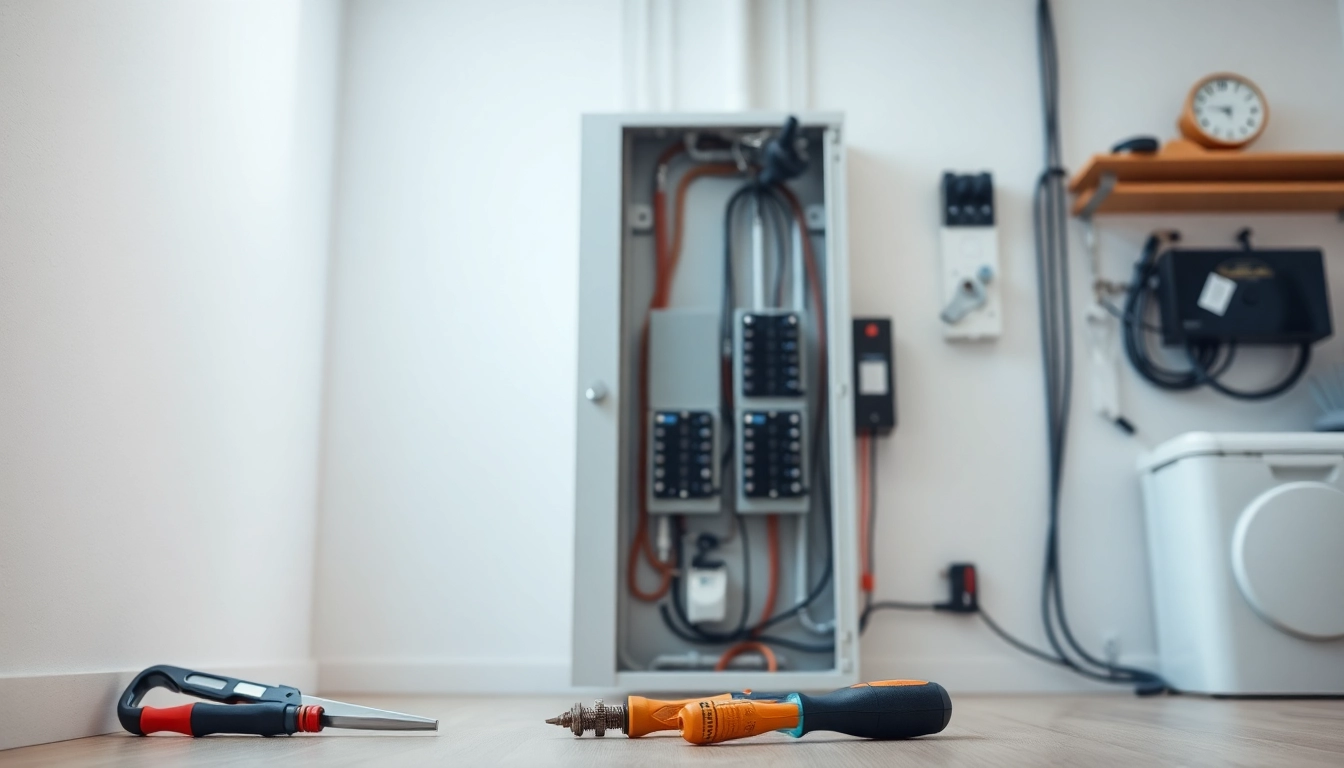Understanding the Electrical Panel
In any modern home, the Electrical Panel serves as the central hub for power distribution, connecting the electricity from the utility company to the various circuits that run through the home. It is crucial for safety and functionality, yet many homeowners remain unaware of its significance until issues arise. This article delves into the complexities of electrical panels, their components, how they function, the signs indicating an upgrade is necessary, types available in the market, the upgrade process, and the cost considerations involved in maintaining an efficient electrical system.
What is an Electrical Panel?
An electrical panel, also referred to as a breaker box or service panel, is a metal box that houses electrical breakers or fuses. Its main function is to receive electricity from the utility provider and distribute it to various circuits throughout the home. This controlled distribution ensures that electrical systems operate safely and effectively, preventing overloads and potential hazards. The panel’s design can vary significantly based on factors like the number of circuits, overall capacity, and specific functionalities such as surge protection.
Components of an Electrical Panel
Understanding the various components of an electrical panel can help homeowners appreciate its significance and troubleshoot minor issues. Key components include:
- Main Breaker: This is a crucial safety feature that controls the flow of electricity into the panel. It can disconnect power, preventing electrical fires and shocks.
- Branch Circuit Breakers: These individual breakers manage specific circuits throughout the home, allowing sections to be powered down without shutting off electricity to the entire house.
- Bus Bars: Conductive strips within the panel that distribute electricity from the main breaker to the branch circuit breakers.
- Ground and Neutral Bars: These components connect ground and neutral wires, respectively, which are essential for preventing electrical faults.
- Enclosure: The outer casing of the panel, designed to protect its internal components from environmental damage and accidental contact.
How Electrical Panels Function
The functionality of an electrical panel hinges on its ability to manage and direct electricity flow safely throughout a home. Incoming power first connects to the main breaker, where it undergoes measurement before being divided among branch circuit breakers. Each breaker corresponds to a specific part of the home, such as living areas, appliances, or outdoor areas. In the event of an overload or fault, the breaker will trip, shutting off electricity to that section, thereby preventing potential hazards like fires. This systematic distribution not only ensures safety but also enhances the overall efficiency of electrical consumption.
Signs You Need to Upgrade Your Electrical Panel
The need to upgrade an electrical panel can arise from various indicators, often stemming from increased usage or outdated systems. Being alert to these signs can help prevent safety hazards and enhance your home’s electrical system.
Common Indicators of an Electrical Panel Issue
Several observable signs can help homeowners identify when an electrical panel requires upgrading:
- Frequent Tripping of Circuit Breakers: If breakers are constantly tripping, this indicates that they are overloaded and unable to support the current demand.
- Burning Smell or Discoloration: Any unusual smells or discoloration around the panel can signal overheating, which may lead to serious safety issues.
- Flickering Lights: Flickering or dimming lights, especially when using multiple devices simultaneously, suggest inadequate power supply.
- Age of the Electrical Panel: Panels older than 20 to 30 years may not meet modern power demands and may lack essential safety features.
- Incompatibility with New Appliances: If a homeowner has added high-demand appliances, including HVAC systems or electric vehicles, the existing panel might struggle to accommodate new loads.
Assessing Your Home’s Electrical Needs
When evaluating whether it’s time to upgrade your electrical panel, it’s vital to assess the current and anticipated electrical load. Factors to consider include:
- Appliance Usage: Analyze the power requirements of appliances in use. Increased usage of high-wattage devices can impose significant loads on a system designed for lower capacities.
- Home Size and Layout: Larger homes with complex layouts typically have greater electrical demands. Evaluate the number of circuits needed for efficient power distribution.
- Future Growth: If you plan renovations, expansions, or purchases of new electrical appliances, consider future load requirements to prevent premature upgrades.
- Local Codes and Standards: Stay informed of any changes in national or local electrical codes that might prompt a necessary panel upgrade.
Safety Issues Related to Outdated Electrical Panels
Outdated electrical panels can pose significant safety risks. The following issues highlight the importance of proactive upgrades:
- Fire Hazards: Overloaded circuits can generate heat, which may lead to electrical fires. An outdated panel is more likely to short circuit.
- Electrical Shocks: Faulty or old wiring presents risks of electric shock. Upgrading ensures compliance with safety standards.
- Inadequate Power Supply: Insufficient voltage can cause appliances to malfunction or become damaged, leading to costly repairs.
- Insurance Issues: Many insurance companies may refuse coverage or charge higher premiums for homes with outdated electrical panels.
Types of Electrical Panels Available
A variety of electrical panels exist, tailored to different needs and specifications. Understanding these options is vital for making an informed decision.
Overview of Different Electrical Panel Types
The principal types of electrical panels include:
- Main Breaker Panels: These panels are common in most homes and control the electricity coming into the building. They usually feature a main breaker and several branch breakers.
- Subpanels: Installed to distribute power to specific areas or large appliances, subpanels act as extensions of the main panel.
- Smart Panels: Modern electrical panels that offer advanced features like remote monitoring, energy management, and integration with smart home systems for enhanced efficiency.
Comparative Analysis of Electrical Panel Features
When selecting an electrical panel, certain features can impact its effectiveness and suitability:
- Load Capacity: Ranging from 100 amp to 400 amp, load capacity dictates how many circuits can be connected without risking overload.
- Surge Protection: Some panels come with built-in surge protectors, safeguarding appliances against voltage spikes.
- Accessibility: An easily accessible panel can ease troubleshooting and simplify maintenance.
- Labeling and Organization: A well-organized panel with clear labels helps ensure safety and effective management of circuits.
Choosing the Right Electrical Panel for Your Home
Selecting the most appropriate electrical panel requires considering various aspects:
- Current and Future Needs: Estimate your current load requirements and anticipate future electrical requirements based on planned home improvements or additional devices.
- Local Electrical Codes: Adhere to building regulations and codes, which may dictate certain features, capacities, or brands must be used.
- Professional Consultation: Engaging an electrician can provide invaluable guidance tailored to your home’s specific electrical configuration and needs.
Upgrading Your Electrical Panel: The Process
Understanding the steps involved in upgrading an electrical panel can help homeowners prepare effectively for the process.
Steps to Prepare for an Electrical Panel Upgrade
Preparation is critical for a successful electrical panel upgrade:
- Evaluate Electrical Needs: Assess your current and future electrical requirements to determine the right panel type and size.
- Assess Panel Location: Ensure there is enough space to accommodate a new panel and it is easily accessible for maintenance.
- Consult Licensed Electricians: Engage experienced professionals to assess your system, handle permits, and ensure safety compliance.
- Ensure Compliance with Local Codes: Verify that the upgrade plans align with local building codes and electrical standards to avoid compliance issues.
What to Expect During Installation
The installation process typically involves several key steps:
- Power Disconnection: The existing electricity supply will be disconnected to facilitate a safe upgrade.
- Removal of the Old Panel: The old electrical panel will be safely removed, often requiring the expertise of licensed electricians.
- Installing the New Panel: The new panel will be installed, with connections made to accommodate existing circuits and wiring.
- Inspection and Testing: The installation should be inspected and tested to ensure it functions correctly and adheres to safety standards.
Post-Upgrade Maintenance for Your Electrical Panel
Once the upgrade is complete, maintaining the panel will ensure its longevity and reliability:
- Regular Inspections: Conduct annual inspections to check for any signs of wear, overheating, or damage.
- Clear Panel Area: Keep the area around the panel clear from clutter to allow access and inspections.
- Proper Labeling: Ensure all circuits are clearly labeled for effective management and quick identification of any issues.
- Professional Checkups: Schedule regular maintenance checks with licensed electricians, particularly if new appliances are integrated.
Cost Considerations for Upgrading Electrical Panels
Upgrading an electrical panel encompasses various costs that homeowners should carefully consider for effective budgeting.
Budgeting for Your Electrical Panel Upgrade
The cost of upgrading generally includes materials, labor, and potential unforeseen expenses:
- Material Costs: The cost for a new panel can range based on capacity, features, and brand. Budget for higher-end options if advanced functionalities, such as smart technology, are included.
- Labor Costs: Hiring licensed professionals is essential for safety and compliance. Labor costs can vary based on geographic location and the complexity of the installation.
- Permit Fees: Local regulations may require permits for electrical upgrades, which can incur additional fees.
Understanding Labor and Material Costs
Labor and material costs can fluctuate based on various factors:
- Panel Size: Larger panels typically require more materials and labor, leading to higher costs.
- Local Rates: Geographic region can significantly impact labor costs, with metropolitan areas generally being pricier.
- Company Reputation: Experienced and reputable electricians may charge more but offer peace of mind and quality work.
Potential Long-term Savings from Upgrading
Investing in an upgraded electrical panel can provide several long-term financial benefits:
- Reduced Energy Bills: Energy-efficient panels can help optimize electricity usage, reducing monthly utility bills.
- Longevity of Appliances: Up-to-date panels help prevent power surges, thereby extending the lifespan of connected equipment and appliances.
- Increased Home Value: A modern electrical system can enhance property value, appealing to potential buyers who prioritize safety and reliability.
- Lower Insurance Premiums: Upgrading may result in lower insurance rates, as modern systems often come with enhanced safety features that reduce risk.


